Angina Management: Nursing Interventions and Ethical Considerations
VerifiedAdded on 2023/01/04
|7
|1848
|78
Report
AI Summary
This report delves into the multifaceted aspects of angina management, focusing on the crucial roles and responsibilities of registered nurses. It begins by exploring the ethical and legal frameworks that guide nursing practice, emphasizing the importance of adhering to professional codes of conduct, such as those established by the Nursing and Midwifery Board of Australia (NMBA). The report then outlines the guidelines for angina management, including diagnosis, risk stratification, treatment, and patient follow-up. A detailed discussion of nursing interventions, such as the administration of antiplatelet agents like Aspirin and vasodilators like Nitrates, is provided, along with a consideration of the underlying pathophysiology of angina. The report stresses the significance of understanding the patient's condition and tailoring interventions to promote recovery. Furthermore, it highlights the ethical considerations associated with these interventions, emphasizing the nurse's role in protecting patient rights, promoting social justice, and ensuring patient safety and satisfaction. The report underscores the importance of ongoing patient monitoring and education to manage any complications that may arise during angina treatment, ultimately reinforcing the significance of ethical and treatment policies in nursing practice. The report concludes by referencing key literature that supports these concepts.
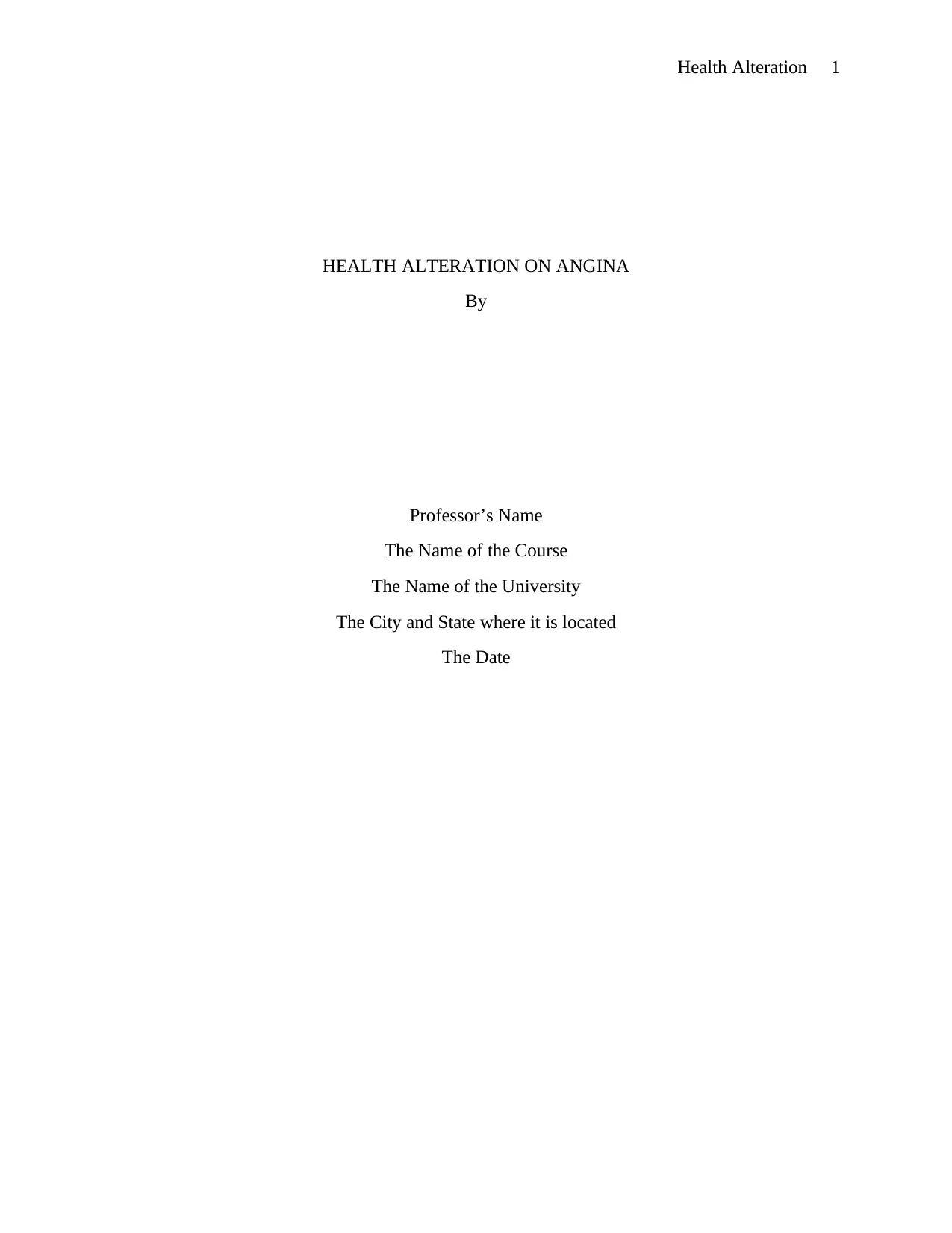
Health Alteration 1
HEALTH ALTERATION ON ANGINA
By
Professor’s Name
The Name of the Course
The Name of the University
The City and State where it is located
The Date
HEALTH ALTERATION ON ANGINA
By
Professor’s Name
The Name of the Course
The Name of the University
The City and State where it is located
The Date
Paraphrase This Document
Need a fresh take? Get an instant paraphrase of this document with our AI Paraphraser
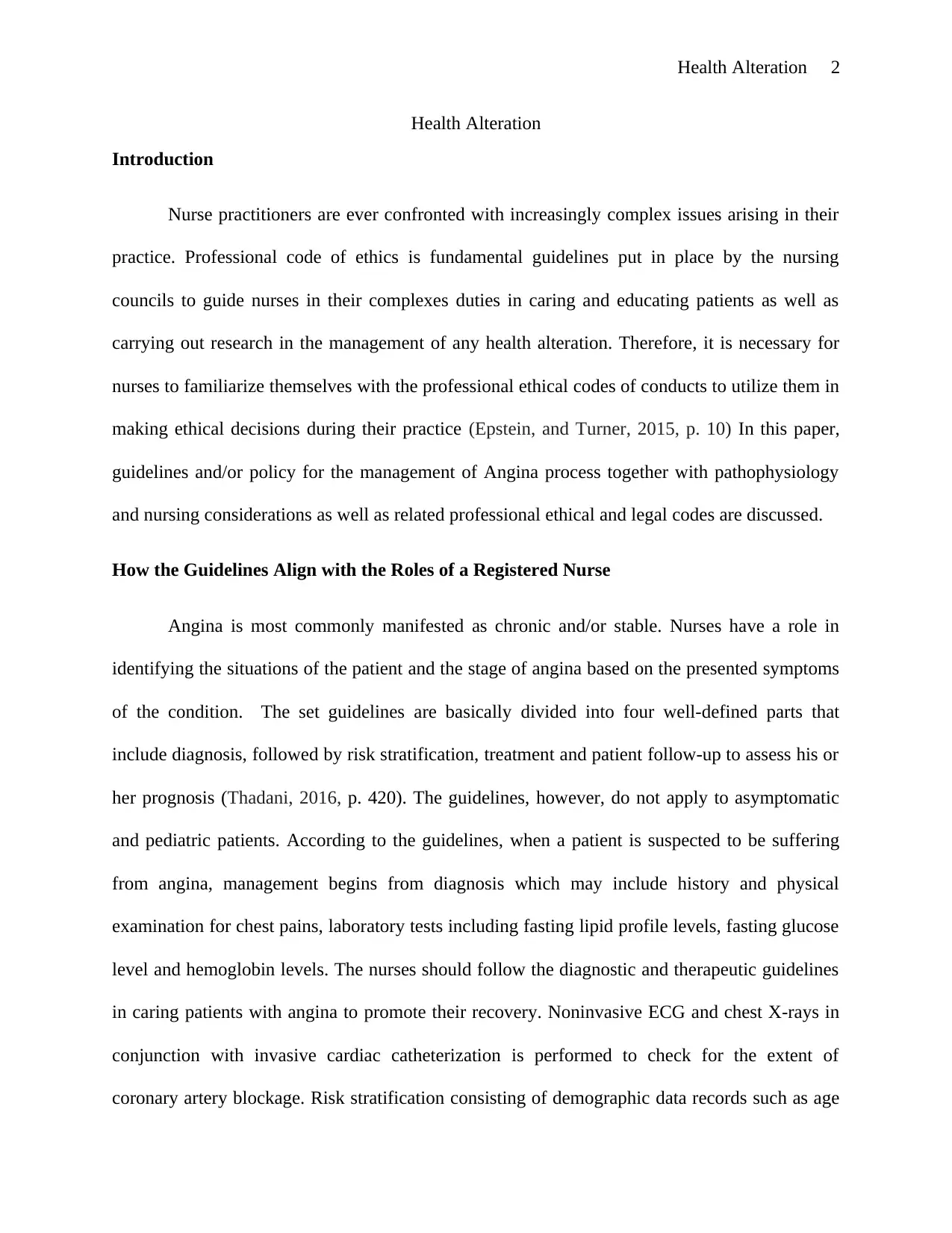
Health Alteration 2
Health Alteration
Introduction
Nurse practitioners are ever confronted with increasingly complex issues arising in their
practice. Professional code of ethics is fundamental guidelines put in place by the nursing
councils to guide nurses in their complexes duties in caring and educating patients as well as
carrying out research in the management of any health alteration. Therefore, it is necessary for
nurses to familiarize themselves with the professional ethical codes of conducts to utilize them in
making ethical decisions during their practice (Epstein, and Turner, 2015, p. 10) In this paper,
guidelines and/or policy for the management of Angina process together with pathophysiology
and nursing considerations as well as related professional ethical and legal codes are discussed.
How the Guidelines Align with the Roles of a Registered Nurse
Angina is most commonly manifested as chronic and/or stable. Nurses have a role in
identifying the situations of the patient and the stage of angina based on the presented symptoms
of the condition. The set guidelines are basically divided into four well-defined parts that
include diagnosis, followed by risk stratification, treatment and patient follow-up to assess his or
her prognosis (Thadani, 2016, p. 420). The guidelines, however, do not apply to asymptomatic
and pediatric patients. According to the guidelines, when a patient is suspected to be suffering
from angina, management begins from diagnosis which may include history and physical
examination for chest pains, laboratory tests including fasting lipid profile levels, fasting glucose
level and hemoglobin levels. The nurses should follow the diagnostic and therapeutic guidelines
in caring patients with angina to promote their recovery. Noninvasive ECG and chest X-rays in
conjunction with invasive cardiac catheterization is performed to check for the extent of
coronary artery blockage. Risk stratification consisting of demographic data records such as age
Health Alteration
Introduction
Nurse practitioners are ever confronted with increasingly complex issues arising in their
practice. Professional code of ethics is fundamental guidelines put in place by the nursing
councils to guide nurses in their complexes duties in caring and educating patients as well as
carrying out research in the management of any health alteration. Therefore, it is necessary for
nurses to familiarize themselves with the professional ethical codes of conducts to utilize them in
making ethical decisions during their practice (Epstein, and Turner, 2015, p. 10) In this paper,
guidelines and/or policy for the management of Angina process together with pathophysiology
and nursing considerations as well as related professional ethical and legal codes are discussed.
How the Guidelines Align with the Roles of a Registered Nurse
Angina is most commonly manifested as chronic and/or stable. Nurses have a role in
identifying the situations of the patient and the stage of angina based on the presented symptoms
of the condition. The set guidelines are basically divided into four well-defined parts that
include diagnosis, followed by risk stratification, treatment and patient follow-up to assess his or
her prognosis (Thadani, 2016, p. 420). The guidelines, however, do not apply to asymptomatic
and pediatric patients. According to the guidelines, when a patient is suspected to be suffering
from angina, management begins from diagnosis which may include history and physical
examination for chest pains, laboratory tests including fasting lipid profile levels, fasting glucose
level and hemoglobin levels. The nurses should follow the diagnostic and therapeutic guidelines
in caring patients with angina to promote their recovery. Noninvasive ECG and chest X-rays in
conjunction with invasive cardiac catheterization is performed to check for the extent of
coronary artery blockage. Risk stratification consisting of demographic data records such as age
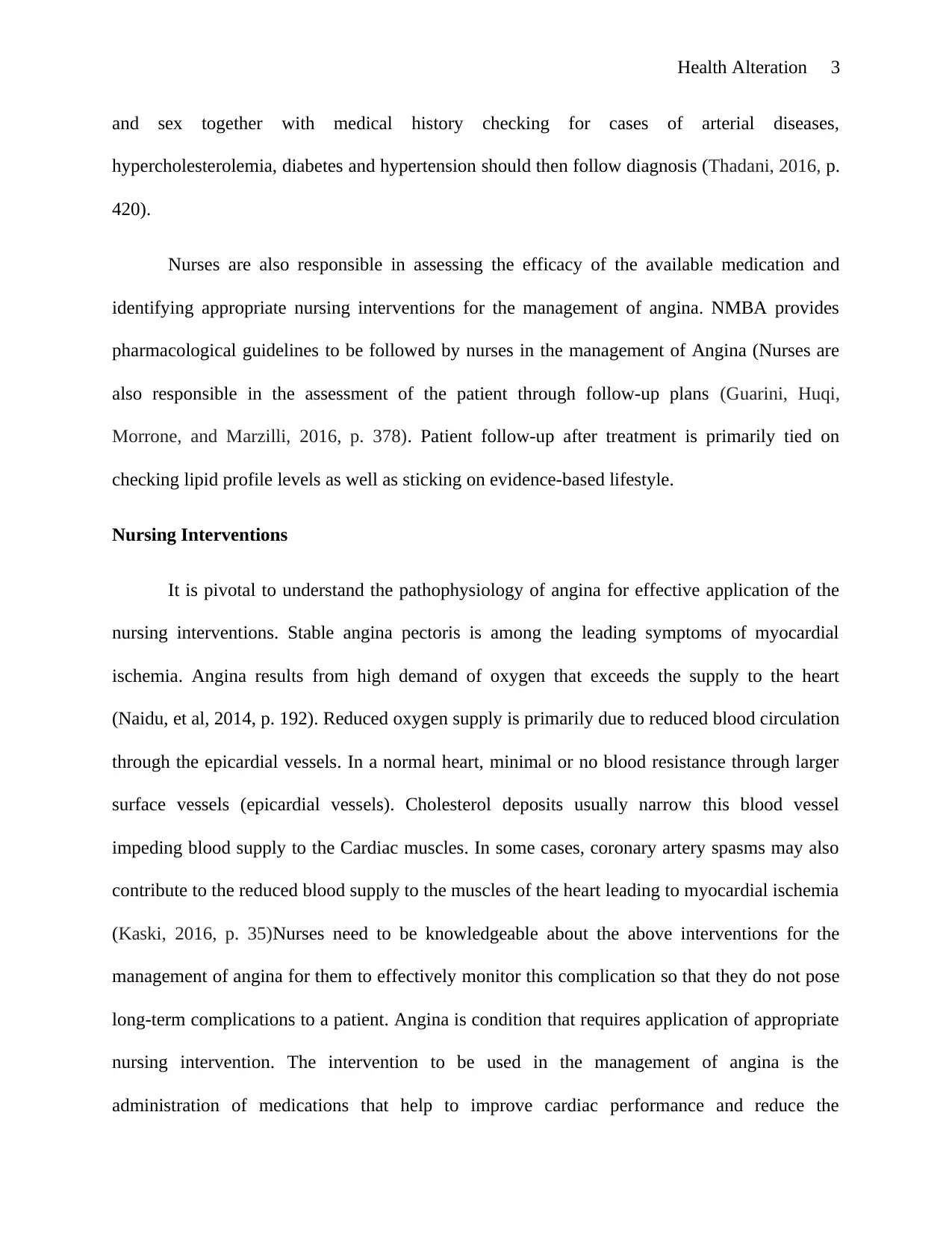
Health Alteration 3
and sex together with medical history checking for cases of arterial diseases,
hypercholesterolemia, diabetes and hypertension should then follow diagnosis (Thadani, 2016, p.
420).
Nurses are also responsible in assessing the efficacy of the available medication and
identifying appropriate nursing interventions for the management of angina. NMBA provides
pharmacological guidelines to be followed by nurses in the management of Angina (Nurses are
also responsible in the assessment of the patient through follow-up plans (Guarini, Huqi,
Morrone, and Marzilli, 2016, p. 378). Patient follow-up after treatment is primarily tied on
checking lipid profile levels as well as sticking on evidence-based lifestyle.
Nursing Interventions
It is pivotal to understand the pathophysiology of angina for effective application of the
nursing interventions. Stable angina pectoris is among the leading symptoms of myocardial
ischemia. Angina results from high demand of oxygen that exceeds the supply to the heart
(Naidu, et al, 2014, p. 192). Reduced oxygen supply is primarily due to reduced blood circulation
through the epicardial vessels. In a normal heart, minimal or no blood resistance through larger
surface vessels (epicardial vessels). Cholesterol deposits usually narrow this blood vessel
impeding blood supply to the Cardiac muscles. In some cases, coronary artery spasms may also
contribute to the reduced blood supply to the muscles of the heart leading to myocardial ischemia
(Kaski, 2016, p. 35)Nurses need to be knowledgeable about the above interventions for the
management of angina for them to effectively monitor this complication so that they do not pose
long-term complications to a patient. Angina is condition that requires application of appropriate
nursing intervention. The intervention to be used in the management of angina is the
administration of medications that help to improve cardiac performance and reduce the
and sex together with medical history checking for cases of arterial diseases,
hypercholesterolemia, diabetes and hypertension should then follow diagnosis (Thadani, 2016, p.
420).
Nurses are also responsible in assessing the efficacy of the available medication and
identifying appropriate nursing interventions for the management of angina. NMBA provides
pharmacological guidelines to be followed by nurses in the management of Angina (Nurses are
also responsible in the assessment of the patient through follow-up plans (Guarini, Huqi,
Morrone, and Marzilli, 2016, p. 378). Patient follow-up after treatment is primarily tied on
checking lipid profile levels as well as sticking on evidence-based lifestyle.
Nursing Interventions
It is pivotal to understand the pathophysiology of angina for effective application of the
nursing interventions. Stable angina pectoris is among the leading symptoms of myocardial
ischemia. Angina results from high demand of oxygen that exceeds the supply to the heart
(Naidu, et al, 2014, p. 192). Reduced oxygen supply is primarily due to reduced blood circulation
through the epicardial vessels. In a normal heart, minimal or no blood resistance through larger
surface vessels (epicardial vessels). Cholesterol deposits usually narrow this blood vessel
impeding blood supply to the Cardiac muscles. In some cases, coronary artery spasms may also
contribute to the reduced blood supply to the muscles of the heart leading to myocardial ischemia
(Kaski, 2016, p. 35)Nurses need to be knowledgeable about the above interventions for the
management of angina for them to effectively monitor this complication so that they do not pose
long-term complications to a patient. Angina is condition that requires application of appropriate
nursing intervention. The intervention to be used in the management of angina is the
administration of medications that help to improve cardiac performance and reduce the
⊘ This is a preview!⊘
Do you want full access?
Subscribe today to unlock all pages.

Trusted by 1+ million students worldwide
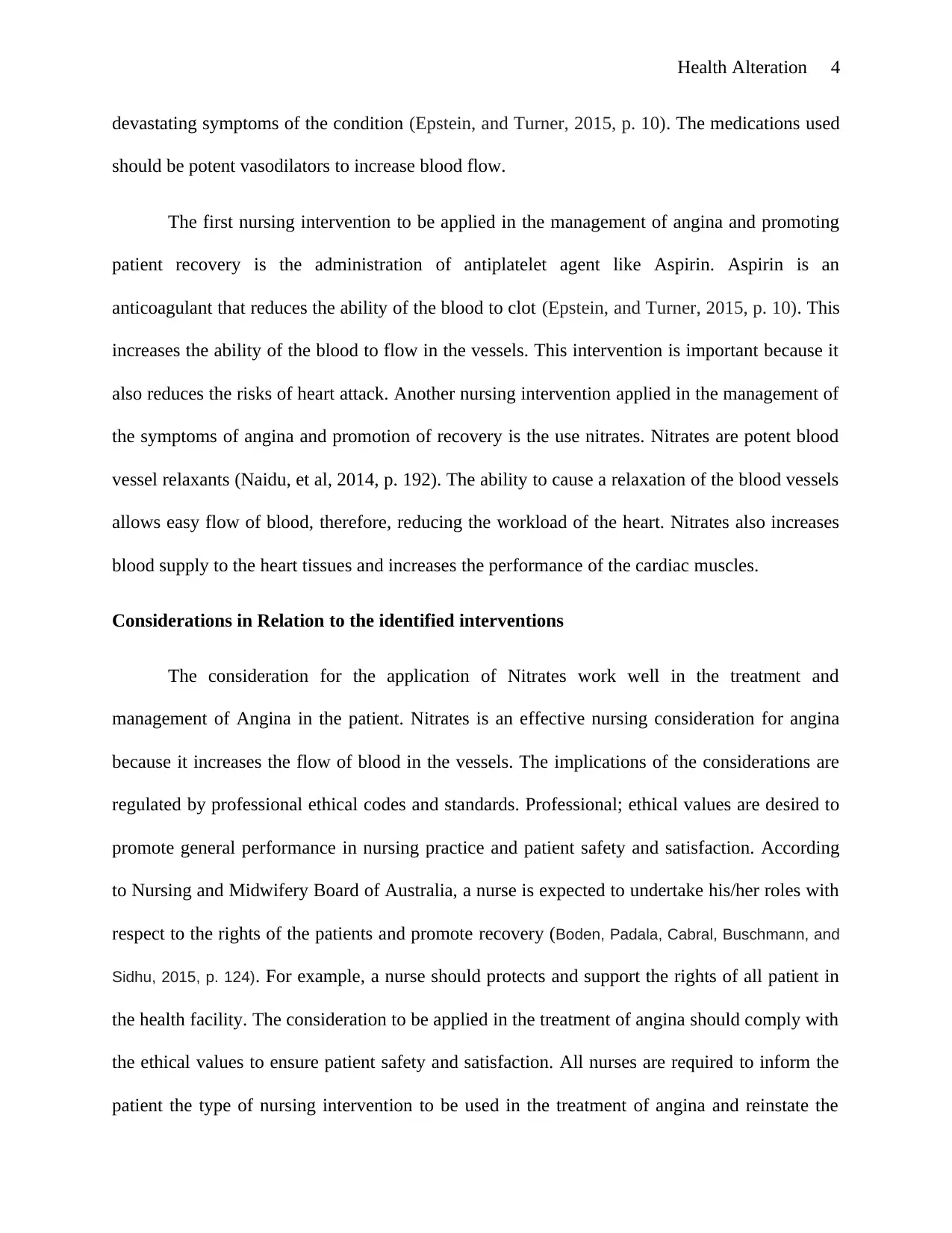
Health Alteration 4
devastating symptoms of the condition (Epstein, and Turner, 2015, p. 10). The medications used
should be potent vasodilators to increase blood flow.
The first nursing intervention to be applied in the management of angina and promoting
patient recovery is the administration of antiplatelet agent like Aspirin. Aspirin is an
anticoagulant that reduces the ability of the blood to clot (Epstein, and Turner, 2015, p. 10). This
increases the ability of the blood to flow in the vessels. This intervention is important because it
also reduces the risks of heart attack. Another nursing intervention applied in the management of
the symptoms of angina and promotion of recovery is the use nitrates. Nitrates are potent blood
vessel relaxants (Naidu, et al, 2014, p. 192). The ability to cause a relaxation of the blood vessels
allows easy flow of blood, therefore, reducing the workload of the heart. Nitrates also increases
blood supply to the heart tissues and increases the performance of the cardiac muscles.
Considerations in Relation to the identified interventions
The consideration for the application of Nitrates work well in the treatment and
management of Angina in the patient. Nitrates is an effective nursing consideration for angina
because it increases the flow of blood in the vessels. The implications of the considerations are
regulated by professional ethical codes and standards. Professional; ethical values are desired to
promote general performance in nursing practice and patient safety and satisfaction. According
to Nursing and Midwifery Board of Australia, a nurse is expected to undertake his/her roles with
respect to the rights of the patients and promote recovery (Boden, Padala, Cabral, Buschmann, and
Sidhu, 2015, p. 124). For example, a nurse should protects and support the rights of all patient in
the health facility. The consideration to be applied in the treatment of angina should comply with
the ethical values to ensure patient safety and satisfaction. All nurses are required to inform the
patient the type of nursing intervention to be used in the treatment of angina and reinstate the
devastating symptoms of the condition (Epstein, and Turner, 2015, p. 10). The medications used
should be potent vasodilators to increase blood flow.
The first nursing intervention to be applied in the management of angina and promoting
patient recovery is the administration of antiplatelet agent like Aspirin. Aspirin is an
anticoagulant that reduces the ability of the blood to clot (Epstein, and Turner, 2015, p. 10). This
increases the ability of the blood to flow in the vessels. This intervention is important because it
also reduces the risks of heart attack. Another nursing intervention applied in the management of
the symptoms of angina and promotion of recovery is the use nitrates. Nitrates are potent blood
vessel relaxants (Naidu, et al, 2014, p. 192). The ability to cause a relaxation of the blood vessels
allows easy flow of blood, therefore, reducing the workload of the heart. Nitrates also increases
blood supply to the heart tissues and increases the performance of the cardiac muscles.
Considerations in Relation to the identified interventions
The consideration for the application of Nitrates work well in the treatment and
management of Angina in the patient. Nitrates is an effective nursing consideration for angina
because it increases the flow of blood in the vessels. The implications of the considerations are
regulated by professional ethical codes and standards. Professional; ethical values are desired to
promote general performance in nursing practice and patient safety and satisfaction. According
to Nursing and Midwifery Board of Australia, a nurse is expected to undertake his/her roles with
respect to the rights of the patients and promote recovery (Boden, Padala, Cabral, Buschmann, and
Sidhu, 2015, p. 124). For example, a nurse should protects and support the rights of all patient in
the health facility. The consideration to be applied in the treatment of angina should comply with
the ethical values to ensure patient safety and satisfaction. All nurses are required to inform the
patient the type of nursing intervention to be used in the treatment of angina and reinstate the
Paraphrase This Document
Need a fresh take? Get an instant paraphrase of this document with our AI Paraphraser
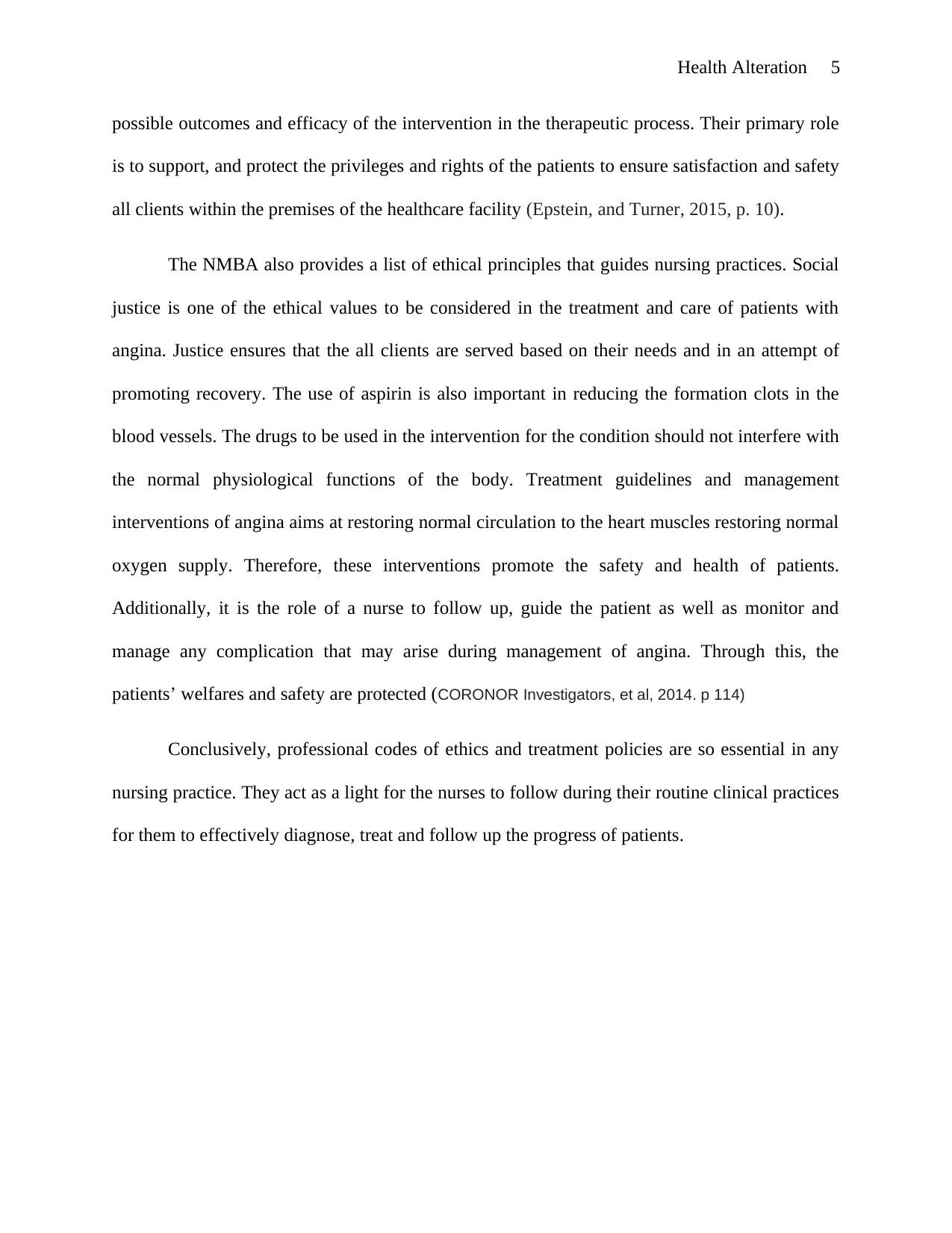
Health Alteration 5
possible outcomes and efficacy of the intervention in the therapeutic process. Their primary role
is to support, and protect the privileges and rights of the patients to ensure satisfaction and safety
all clients within the premises of the healthcare facility (Epstein, and Turner, 2015, p. 10).
The NMBA also provides a list of ethical principles that guides nursing practices. Social
justice is one of the ethical values to be considered in the treatment and care of patients with
angina. Justice ensures that the all clients are served based on their needs and in an attempt of
promoting recovery. The use of aspirin is also important in reducing the formation clots in the
blood vessels. The drugs to be used in the intervention for the condition should not interfere with
the normal physiological functions of the body. Treatment guidelines and management
interventions of angina aims at restoring normal circulation to the heart muscles restoring normal
oxygen supply. Therefore, these interventions promote the safety and health of patients.
Additionally, it is the role of a nurse to follow up, guide the patient as well as monitor and
manage any complication that may arise during management of angina. Through this, the
patients’ welfares and safety are protected (CORONOR Investigators, et al, 2014. p 114)
Conclusively, professional codes of ethics and treatment policies are so essential in any
nursing practice. They act as a light for the nurses to follow during their routine clinical practices
for them to effectively diagnose, treat and follow up the progress of patients.
possible outcomes and efficacy of the intervention in the therapeutic process. Their primary role
is to support, and protect the privileges and rights of the patients to ensure satisfaction and safety
all clients within the premises of the healthcare facility (Epstein, and Turner, 2015, p. 10).
The NMBA also provides a list of ethical principles that guides nursing practices. Social
justice is one of the ethical values to be considered in the treatment and care of patients with
angina. Justice ensures that the all clients are served based on their needs and in an attempt of
promoting recovery. The use of aspirin is also important in reducing the formation clots in the
blood vessels. The drugs to be used in the intervention for the condition should not interfere with
the normal physiological functions of the body. Treatment guidelines and management
interventions of angina aims at restoring normal circulation to the heart muscles restoring normal
oxygen supply. Therefore, these interventions promote the safety and health of patients.
Additionally, it is the role of a nurse to follow up, guide the patient as well as monitor and
manage any complication that may arise during management of angina. Through this, the
patients’ welfares and safety are protected (CORONOR Investigators, et al, 2014. p 114)
Conclusively, professional codes of ethics and treatment policies are so essential in any
nursing practice. They act as a light for the nurses to follow during their routine clinical practices
for them to effectively diagnose, treat and follow up the progress of patients.
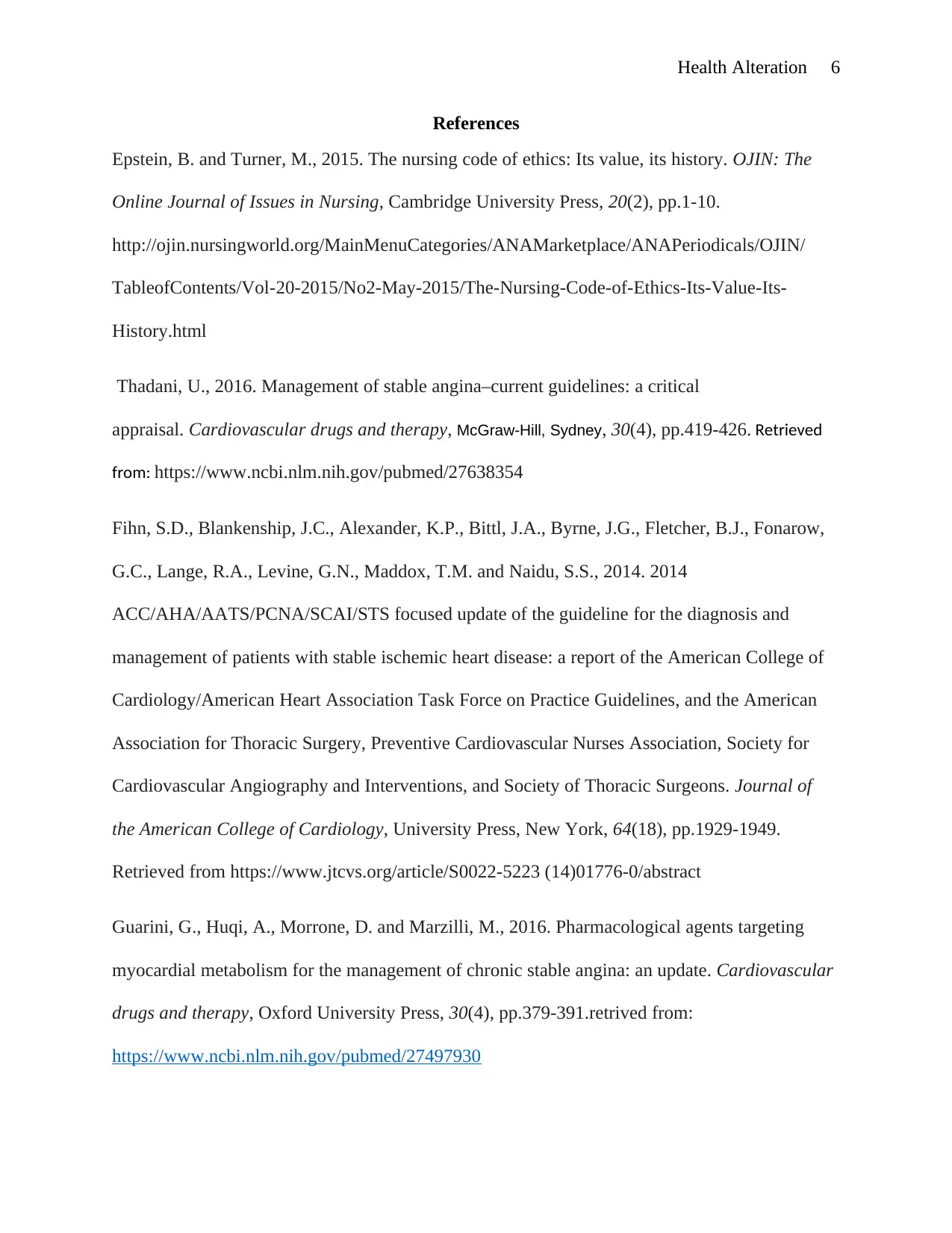
Health Alteration 6
References
Epstein, B. and Turner, M., 2015. The nursing code of ethics: Its value, its history. OJIN: The
Online Journal of Issues in Nursing, Cambridge University Press, 20(2), pp.1-10.
http://ojin.nursingworld.org/MainMenuCategories/ANAMarketplace/ANAPeriodicals/OJIN/
TableofContents/Vol-20-2015/No2-May-2015/The-Nursing-Code-of-Ethics-Its-Value-Its-
History.html
Thadani, U., 2016. Management of stable angina–current guidelines: a critical
appraisal. Cardiovascular drugs and therapy, McGraw-Hill, Sydney, 30(4), pp.419-426. Retrieved
from: https://www.ncbi.nlm.nih.gov/pubmed/27638354
Fihn, S.D., Blankenship, J.C., Alexander, K.P., Bittl, J.A., Byrne, J.G., Fletcher, B.J., Fonarow,
G.C., Lange, R.A., Levine, G.N., Maddox, T.M. and Naidu, S.S., 2014. 2014
ACC/AHA/AATS/PCNA/SCAI/STS focused update of the guideline for the diagnosis and
management of patients with stable ischemic heart disease: a report of the American College of
Cardiology/American Heart Association Task Force on Practice Guidelines, and the American
Association for Thoracic Surgery, Preventive Cardiovascular Nurses Association, Society for
Cardiovascular Angiography and Interventions, and Society of Thoracic Surgeons. Journal of
the American College of Cardiology, University Press, New York, 64(18), pp.1929-1949.
Retrieved from https://www.jtcvs.org/article/S0022-5223 (14)01776-0/abstract
Guarini, G., Huqi, A., Morrone, D. and Marzilli, M., 2016. Pharmacological agents targeting
myocardial metabolism for the management of chronic stable angina: an update. Cardiovascular
drugs and therapy, Oxford University Press, 30(4), pp.379-391.retrived from:
https://www.ncbi.nlm.nih.gov/pubmed/27497930
References
Epstein, B. and Turner, M., 2015. The nursing code of ethics: Its value, its history. OJIN: The
Online Journal of Issues in Nursing, Cambridge University Press, 20(2), pp.1-10.
http://ojin.nursingworld.org/MainMenuCategories/ANAMarketplace/ANAPeriodicals/OJIN/
TableofContents/Vol-20-2015/No2-May-2015/The-Nursing-Code-of-Ethics-Its-Value-Its-
History.html
Thadani, U., 2016. Management of stable angina–current guidelines: a critical
appraisal. Cardiovascular drugs and therapy, McGraw-Hill, Sydney, 30(4), pp.419-426. Retrieved
from: https://www.ncbi.nlm.nih.gov/pubmed/27638354
Fihn, S.D., Blankenship, J.C., Alexander, K.P., Bittl, J.A., Byrne, J.G., Fletcher, B.J., Fonarow,
G.C., Lange, R.A., Levine, G.N., Maddox, T.M. and Naidu, S.S., 2014. 2014
ACC/AHA/AATS/PCNA/SCAI/STS focused update of the guideline for the diagnosis and
management of patients with stable ischemic heart disease: a report of the American College of
Cardiology/American Heart Association Task Force on Practice Guidelines, and the American
Association for Thoracic Surgery, Preventive Cardiovascular Nurses Association, Society for
Cardiovascular Angiography and Interventions, and Society of Thoracic Surgeons. Journal of
the American College of Cardiology, University Press, New York, 64(18), pp.1929-1949.
Retrieved from https://www.jtcvs.org/article/S0022-5223 (14)01776-0/abstract
Guarini, G., Huqi, A., Morrone, D. and Marzilli, M., 2016. Pharmacological agents targeting
myocardial metabolism for the management of chronic stable angina: an update. Cardiovascular
drugs and therapy, Oxford University Press, 30(4), pp.379-391.retrived from:
https://www.ncbi.nlm.nih.gov/pubmed/27497930
⊘ This is a preview!⊘
Do you want full access?
Subscribe today to unlock all pages.

Trusted by 1+ million students worldwide
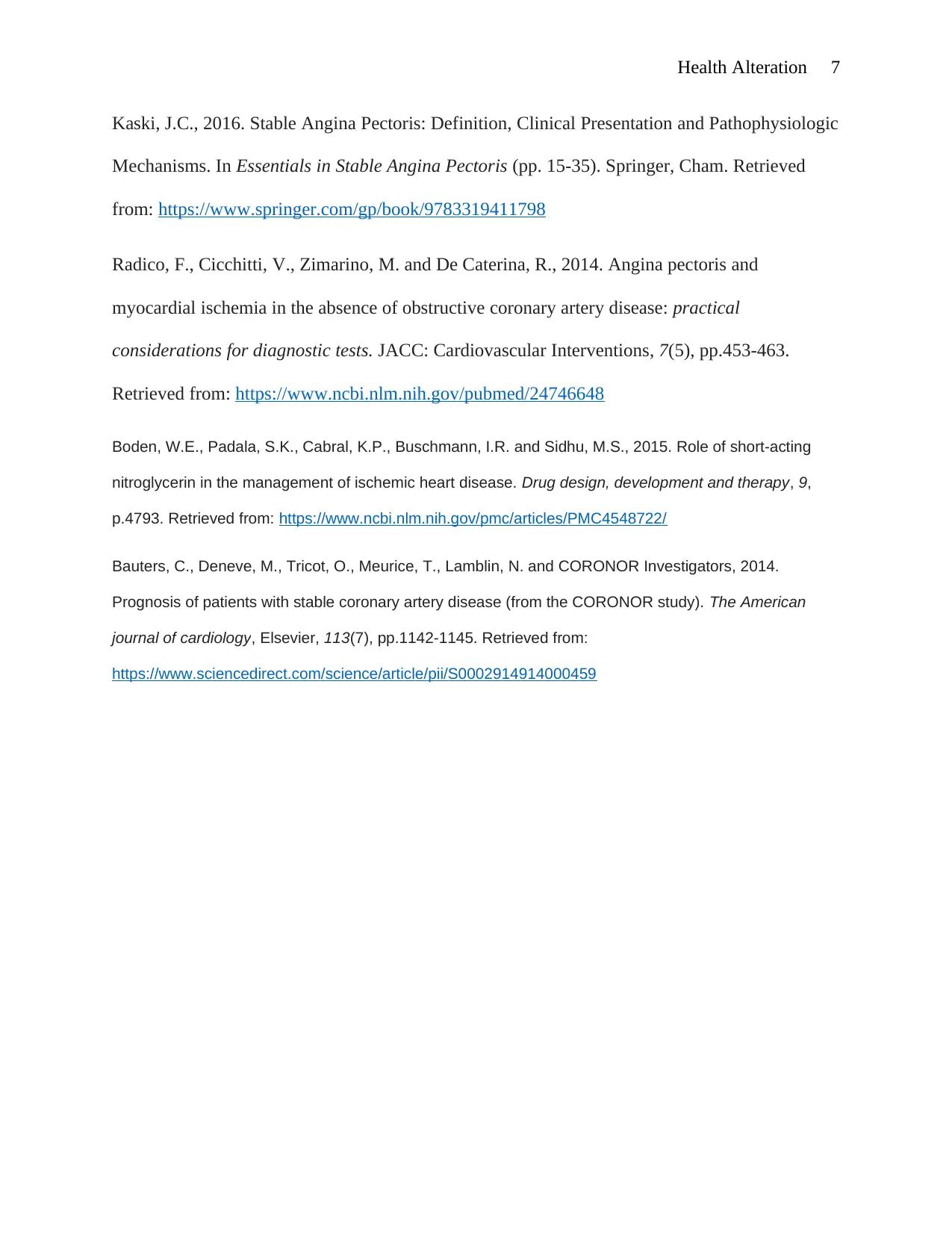
Health Alteration 7
Kaski, J.C., 2016. Stable Angina Pectoris: Definition, Clinical Presentation and Pathophysiologic
Mechanisms. In Essentials in Stable Angina Pectoris (pp. 15-35). Springer, Cham. Retrieved
from: https://www.springer.com/gp/book/9783319411798
Radico, F., Cicchitti, V., Zimarino, M. and De Caterina, R., 2014. Angina pectoris and
myocardial ischemia in the absence of obstructive coronary artery disease: practical
considerations for diagnostic tests. JACC: Cardiovascular Interventions, 7(5), pp.453-463.
Retrieved from: https://www.ncbi.nlm.nih.gov/pubmed/24746648
Boden, W.E., Padala, S.K., Cabral, K.P., Buschmann, I.R. and Sidhu, M.S., 2015. Role of short-acting
nitroglycerin in the management of ischemic heart disease. Drug design, development and therapy, 9,
p.4793. Retrieved from: https://www.ncbi.nlm.nih.gov/pmc/articles/PMC4548722/
Bauters, C., Deneve, M., Tricot, O., Meurice, T., Lamblin, N. and CORONOR Investigators, 2014.
Prognosis of patients with stable coronary artery disease (from the CORONOR study). The American
journal of cardiology, Elsevier, 113(7), pp.1142-1145. Retrieved from:
https://www.sciencedirect.com/science/article/pii/S0002914914000459
Kaski, J.C., 2016. Stable Angina Pectoris: Definition, Clinical Presentation and Pathophysiologic
Mechanisms. In Essentials in Stable Angina Pectoris (pp. 15-35). Springer, Cham. Retrieved
from: https://www.springer.com/gp/book/9783319411798
Radico, F., Cicchitti, V., Zimarino, M. and De Caterina, R., 2014. Angina pectoris and
myocardial ischemia in the absence of obstructive coronary artery disease: practical
considerations for diagnostic tests. JACC: Cardiovascular Interventions, 7(5), pp.453-463.
Retrieved from: https://www.ncbi.nlm.nih.gov/pubmed/24746648
Boden, W.E., Padala, S.K., Cabral, K.P., Buschmann, I.R. and Sidhu, M.S., 2015. Role of short-acting
nitroglycerin in the management of ischemic heart disease. Drug design, development and therapy, 9,
p.4793. Retrieved from: https://www.ncbi.nlm.nih.gov/pmc/articles/PMC4548722/
Bauters, C., Deneve, M., Tricot, O., Meurice, T., Lamblin, N. and CORONOR Investigators, 2014.
Prognosis of patients with stable coronary artery disease (from the CORONOR study). The American
journal of cardiology, Elsevier, 113(7), pp.1142-1145. Retrieved from:
https://www.sciencedirect.com/science/article/pii/S0002914914000459
1 out of 7
Related Documents
Your All-in-One AI-Powered Toolkit for Academic Success.
+13062052269
info@desklib.com
Available 24*7 on WhatsApp / Email
![[object Object]](/_next/static/media/star-bottom.7253800d.svg)
Unlock your academic potential
Copyright © 2020–2025 A2Z Services. All Rights Reserved. Developed and managed by ZUCOL.





